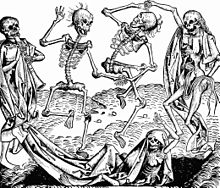Totentanz(Liszt)
Totentanz(English:Dance of the Dead):Paraphrase onDies irae,S.126,is the name of a work for solopianoandorchestrabyFranz Lisztnotable for being based on theGregorianplainchantmelodyDies iraeas well as for stylistic innovations. It was first planned in 1838, completed and published in 1849, and revised in 1853 and 1859.
Obsession with death
[edit]
Some of the titles of Liszt’s pieces, such asTotentanz,Funérailles,La lugubre gondolaandPensée des morts,show the composer'sfascination with death.In the young Liszt we can already observe manifestations of his obsession with death, with religion, and with heaven and hell. According toAlan Walker,[1]Liszt frequented Parisian "hospitals, gambling casinos and asylums" in the early 1830s, and he even went down into prison dungeons in order to see those condemned to die.
Sources of inspiration
[edit]
In theRomanticage, due to a fascination with everythingMedieval,the aspect of fantastic or grotesquely macabreironyoften replaced the original moral intent. A musical example of such irony can be found in the last movement of theSymphonie fantastiquebyHector Berliozwhich quotes the medieval (Gregorian)Dies Irae(Day of Judgment) melody in a shockingly modernistic manner. In 1830 Liszt attended the first performance of the symphony and was struck by its powerful originality. Liszt'sTotentanz(Dance of Death), a set ofvariationsfor piano and orchestra, also paraphrases theDies Iraeplainsong.
Another source of inspiration for the young Liszt was the famousfresco"Triumph of Death" byFrancesco Traini(at Liszt's time attributed toAndrea Orcagnaand today also toBuonamico Buffalmacco) in theCampo Santo,Pisa.Liszt had eloped to Italy with his mistress, theCountess d’Agoult,and in 1838 he visited Pisa. Only ten years later, Liszt's first sketches materialized into a complete version of hisTotentanz.Revisions followed in 1853 and 1859, and its final form was first performed atThe Hagueon 15 April 1865 by Liszt's studentHans von Bülow,to whom the work is dedicated.
Stylistic innovations
[edit]
Since it is based on Gregorian material, Liszt'sTotentanzcontains Medieval sounding passages withcanoniccounterpoint,but by far the most innovative aspect of the scoring is the shockingly modernistic, evenpercussive,nature of the piano part. The opening comes surprisingly close to the introduction inBartók'sSonata for Two Pianos and Percussion,a work composed almost a hundred years later. This may be no coincidence since Bartók frequently performed Liszt'sTotentanz.Other modernistic features are thetoccatalike sections where the pianist's repeated notes beat with diabolic intensity and special sound effects in the orchestra—for example, thecol legnoin the strings sound like shuddering or clanking bones.Richard Pohl(an early biographer) notes, "Every variation discloses some new character—the earnest man, the flighty youth, the scornful doubter, the prayerful monk, the daring soldier, the tender maiden, the playful child."[2]
Extant versions
[edit]Like most Liszt pieces, a number of versions exist. Next to Liszt's first version of theTotentanza secondDe Profundisversion was prepared from Liszt's manuscript sources byFerruccio Busoni(1919). The standard version is the final and third version of the piece (1859). Liszt also wrote versions for two pianos (S.652) and solo piano (S.525). Edited byEmil von Sauer,the original edition for two pianos, however, merely incorporated the solo part of Liszt's rendering for piano and orchestra, with a transcription of the orchestral accompaniment in the second piano.[3]Dr.Andrey Kasparovhas since re-imagined this setting as a work for piano duo.[4]It shows to great effect the breadth of theTotentanz,when distributed evenly between two performers.
Stephen Tharphas transcribed the work for solo organ.[5]
Notable performers
[edit]Besides the performances byHans von Bülow,Béla Bartók,Sergei RachmaninoffandFerruccio Busoni,performances of historic significance include those of the Liszt studentJosé Vianna da Motta(1945 – Port Nat S IPL 108), as well asGyörgy Cziffra(EMI 74012 2),Claudio Arrau,Jorge Bolet(Decca),Arturo Benedetti Michelangeli(1961 – Arkadia HP 507.1; 1962 – Memoria 999-001),Michel Béroff(EMI Classics),Byron Janis(RCA),Martha Argerich,Krystian Zimerman(Deutsche Grammophon),Arnaldo Cohen(Naxos and BIS),Raymond Lewenthal,andEnrico Paceat theSecond International Franz Liszt Piano Competitionin 1989.
Notes
[edit]- ^Walker, Alan(1983).Franz Liszt: The Virtuoso Years 1811–1847.Faber and Faber. p. 152.
- ^Pohl, Richard(1883).Franz Liszt. Studien und Erinnerungen: Gesammelte Schriften über Musik und Musiker,vol.2.Leipzig: Bernhard Schlicke. p. 402.
- ^von Sauer, Emil(5 October 2013)."Petrucci Music Library | Totentanz | S.126 (Liszt, Franz)".Imslp.org.Retrieved7 January2015.
- ^Campbell, John (17 February 2014)."Artsong Update | Reviews | Norfolk Chamber Consort: Berlin Philharmonic Wind Quintet with Andrey Kasparov, Piano".Artsongupdate.org.Retrieved27 July2014.
- ^"World Premieres and Transcriptions, Volume 1".

